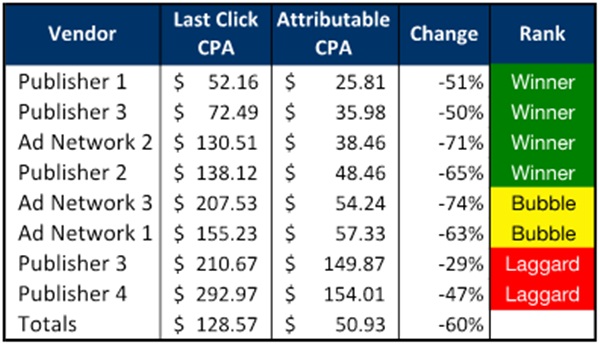Demystifying Attribution: How To Simplify The Process Of Attributing CredIt In A User’s Path To Conversion
by Ciaran O'Kane on 7th Mar 2012 in News


MediaMind and Encore Media Metrics announced a partnership this month that aims to help marketers understand attribution credit across digital campaigns. Here Steve Latham, Founder and CEO, Encore Media Metrics, explains how marketers can simplify the process of attributing credIt in a user’s path to conversion.
Attribution is a hot topic! As marketers are shifting their focus to measurement and optimisation, attribution is rising to the top of the priority list for 2012. However, like many things, attribution has many flavours and often means different things to different people. In this article, I will shed some needed light on this topic and help marketers make sense of this complicated and ever-evolving discipline.
For starters, let’s define Attribution: it is simply the process of attributing credit to each interaction in a user’s path to conversion. These interactions may include display ads, paid searches, natural searches, emails, social and other media. To truly optimise your online marketing efforts, we must measure each channel, vendor, placement and keyword’s contribution, and give appropriate credit in the final analysis. While the industry generally agrees on the problem (last-click measurement is woefully insufficient) and the objectives (give credit where it’s due), there are many divergent opinions on which approach is best for solving this problem. With the goal of illuminating and educating (vs. selling) here is my perspective.
Analysing Conversion Paths
Conversion path analysis is quite popular these days and is usually at the top of marketers’ wish lists. Not to be confused with site-specific conversion analysis, media-centric “conversion path analysis” looks at the digital channels that influence customers throughout the conversion cycle. In short, marketers want to a macro-view of all the touch points (we call them “assists”) that drive a conversion.
To capture the data needed to view conversion paths, you need to match impression cookies (set by an ad server such as MediaMind when a user is exposed to display ads) and your site visitor cookies (set by your site analytics software). You’ll also need to maintain all the details for each impression or visit as time-stamped, individual records are a key requirement for conversion path analysis and more advanced attribution.
Once you have the detailed history of impressions, clicks, visits and actions for each visitor, you can query the data to visualise the conversion paths for those who converted.
The table below shows the “average” path for all visitors, as well as the common paths for 4 unique groups of converters (segmented into natural clusters by a machine-learning algorithm). As noted, the “average” converter saw 6.8 display ads and visited the site 2.9 times before converting, with natural search accounting for 0.4 visits, paid search 0.4 visits and display ads 0.9 visits.

Most marketers are content with channel-specific conversion paths, but we’re seeing more and more interest in vendor and placement specific paths and expect this will become more common over time.
Conversion path analysis is a good start towards cross-channel / full-funnel attribution and should provide a foundation for more advanced (and necessary) analysis. That said, there are a few limitations that marketers should be aware of when looking at conversion paths.
First, it’s important to note that Averages can be misleading and there is usually a broad distribution of paths that are not represented by the mean. While the average number of impressions was 6.8 in the case above, the number varied between 1.5 and 20 for each group (that’s a big range). Likewise, while Display accounted for 70% (on average) of interactions that led to a conversion, it ranged between 38% and 88% among the four clusters.
Second, while conversion path analysis is insightful (and may help justify your display buys), you’ll need more information to truly understand campaign performance and determine how to optimise your media plan. This is where attribution comes into the picture.
Moving Beyond Conversion Paths to Full Attribution
If you have detailed conversion paths for each visitor, you have the data you need for advanced analysis. Now you need a model that allocates credit for every impression and click assist in a way that makes sense.
And now we move into the realm of debate and disagreement that is characterised by “my math is better than your math.” Truth is, attribution models come in all shapes and sizes; some are proprietary and some are based on well-known statistical methodologies. While there is no universally-accepted algorithm that constitutes the gold standard in attribution modelling, there are numerous approaches that are more than sufficient. The good news is that you don’t need a 99.9% solution to be successful. In most cases, a 90% solution is sufficient and more cost-effective.
So without getting too deep into attribution modelling, let’s talk about the questions your attribution model should answer, such as:
- What is the relative contribution of each channel, vendor, placement or keyword (i.e. how many conversions should each get credit for)?
- What is the attributable cost per action (or return on spend) for each channel, vendor, placement or keyword? (see sample report below)
- How many impressions are required to influence a visit and/or a conversion? (i.e. what is the optimal frequency?)
- How does the optimal frequency vary by vendor or placement?
- What was the actual frequency (and how many impressions were wasted)?
- What is the appropriate look-back period (how far back should we give credit for assist impressions and clicks)?

Armed with answers to these questions, campaign optimisation is very straightforward: allocate budget to your best performers and tighten your frequency to reduce waste and increase reach. While there are many additional factors and attributes to measure, taking these basic steps will produce much deeper insights and dramatic improvements in performance.
Hopefully you’re now on your way to understanding the difference between Conversion Path Analysis and Attribution Modelling.
AdvertiserAnalyticsattributionDisplay








Follow ExchangeWire